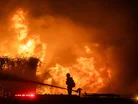LA Fires Set to Cost Insurers US$8bn Amid Market Exodus

The Los Angeles wildfires are expected to generate insurance claims of more than US$8bn, according to analysts at Morningstar and JP Morgan, as California faces mounting pressure on its insurance market structure.
AccuWeather, the private weather forecasting firm, projects total economic losses between US$135bn and US$150bn as fires continue to spread through areas with high-value property concentration.
Market Implications
The disaster arrives at a critical moment for California's insurance sector. State Farm, the US's largest property insurer, had already ceased providing coverage to property owners in Pacific Palisades in July 2024, according to State Farm President Denise Hardin's letter to regulators. The firm declined to renew 70% of policies in the area.
The California Fair Access to Insurance Requirements (FAIR) plan, a state-mandated insurance pool that serves as a provider of last resort, has seen policy numbers double since 2020 to 450,000 as of September 2024.
The plan requires all insurers operating in California to contribute to expenses proportional to their market share.
“Increased recovery costs will likely drive up premiums and may reduce property insurance availability”
Market Stability Concerns
Seven of California's twelve largest insurers have reduced coverage in the past two years, either by halting new policies or declining renewals. The trend reflects growing concern over climate-related risks in the region.
Denise Rappmund, Senior Analyst at Moody's Ratings, a credit rating agency, tells the BBC: “Increased recovery costs will likely drive up premiums and may reduce property insurance availability.”
The FAIR plan's exposure in Pacific Palisades increased 85% between 2023 and 2024, growing at twice the state average. The area now represents US$5.9bn in potential liability for the programme.
Structural Pressures
The FAIR plan faces structural challenges. Victoria Roach, FAIR plan president, testified in March that the programme held US$200m in surplus capital against potential losses of US$300bn.
Private insurers must cover the first US$1bn of claims exceeding FAIR plan reserves, says Dave Jones, former California Insurance Commissioner and current director of the Climate Risk Initiative at Berkeley Law, speaking to the Washington Post.
The plan's US$3m policy cap falls below median property values in affected areas, creating potential coverage gaps, according to Amy Bach, executive director at United Policyholders, a consumer advocacy organisation.
Regulatory Response
California's insurance regulator introduced reforms in December 2024 permitting insurers to incorporate climate risk modelling into pricing and increase rates, provided they maintain coverage in fire-prone regions.
Carolyn Kousky, Associate Vice President for economics and policy at the Environmental Defense Fund, tells the Washington Post the reforms had generated optimism about market stabilisation before the fires began.
“We're hoping they will build a foundation for a strong, competitive insurance market,” adds Denneile Ritter, Vice President at the American Property Casualty Insurance Association.
Physical Impact
Fire authorities report the Palisades blaze has destroyed 5,300 structures, while the separate Eaton Fire has claimed 5,000 buildings.
The disaster may surpass the 2018 Camp Fire in northern California, which generated US$12.5bn in insured losses according to Aon, the insurance broker.
AccuWeather Chief Meteorologist Jonathan Porter tells the BBC the fires could have lasting effects on regional health and tourism.
The firm projects economic impact through various channels including property damage, business interruption, and environmental degradation.
US mortgage lenders typically require property insurance as a condition of lending. As private coverage becomes scarcer, property owners increasingly rely on state-backed options despite higher premiums and reduced protection levels.
“The fires raise the question: Is that enough when we're in an environment of increasing risk?” Kousky tells the Washington Post.
Make sure you check out the latest industry news and insights at InsurTech and be part of the conversation at our global conference series, FinTech LIVE.
Discover all our upcoming events and secure your tickets today.
InsurTech is a BizClik brand




